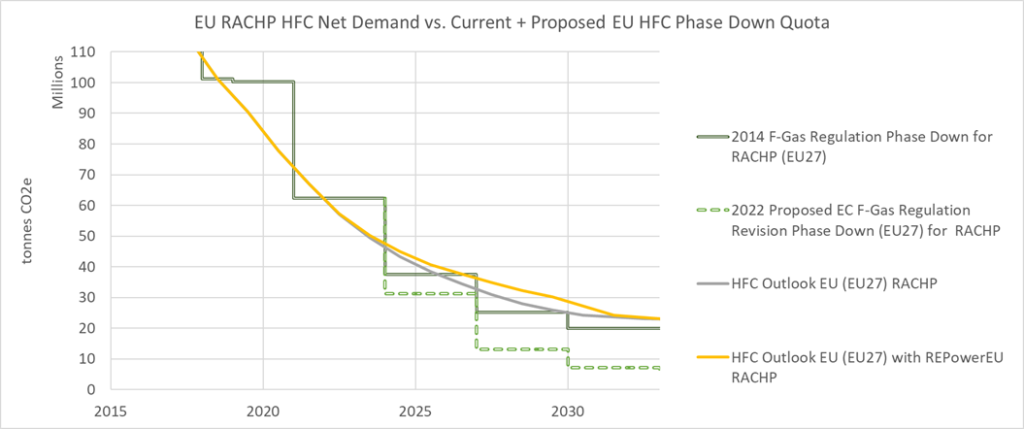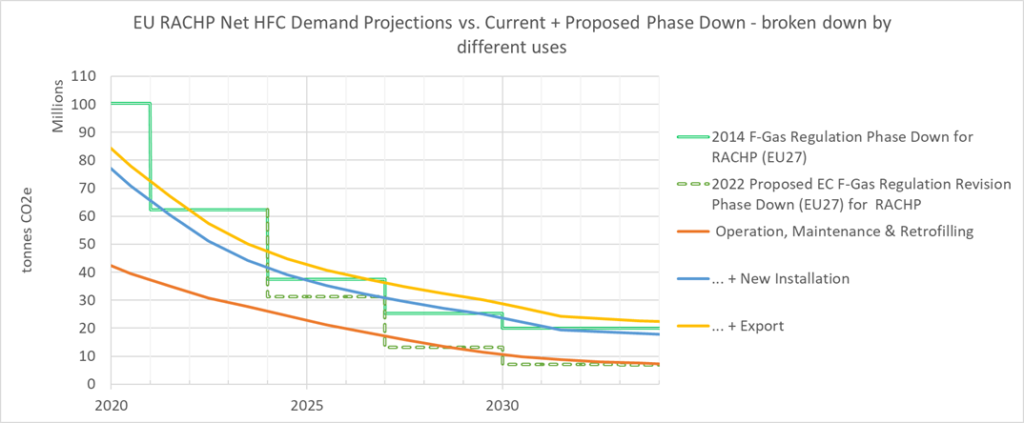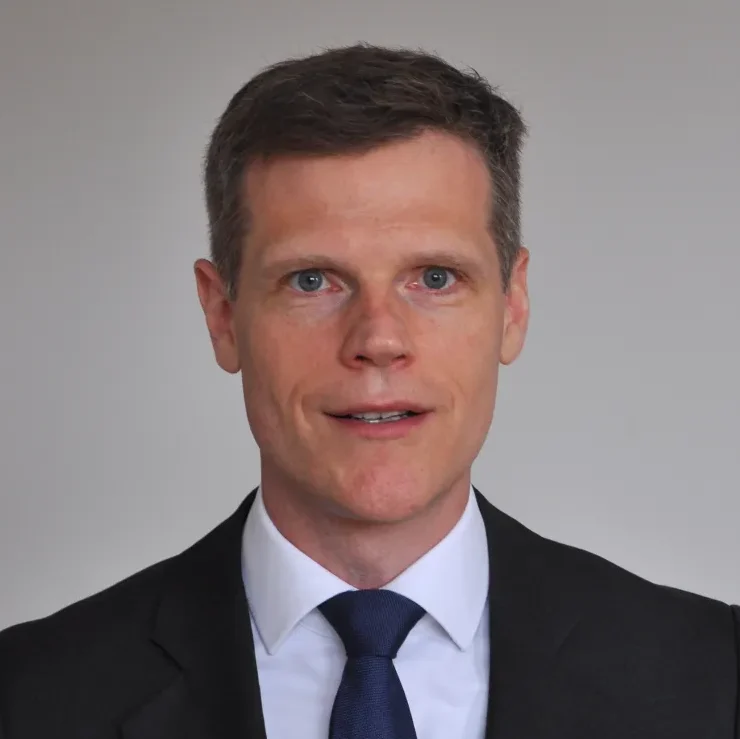Europe is simultaneously facing a climate change ‘emergency’ and a geo-political challenge of rapidly decreasing its reliance on imported fossil fuels. Two fundamental strategic questions where a massive rollout of heat pumps is seen by policy makers as large part of the solution. However, the latest modelling by EPEE raises serious questions on whether there will in fact be sufficient HFC refrigerants available to make the heat pump rollout a reality.
On 5 April, the European Commission published its Proposal for the revision of the 2014 F-gas Regulation[1], to promote the reduction of the amount of HFCs placed on the EU market by 98% by 2050, as compared to 2015 levels. This includes a wide range of proposed measures, including a stricter EU’s HFC phase-down mechanism, new restrictions, the removal of existing exemptions and additional requirements on F-Gases and F-Gas equipment.
Meanwhile, the EU institutions are in the process of endorsing their recently reviewed assumptions, in the context of ambitious legislative targets in terms of energy efficiency, energy savings, and climate neutrality objectives to be achieved by 2050[2]. This includes a reduction of Greenhouse Gas (GHG) emissions by at least 55% by 2030, compared to 1990 levels, outlined in several EU energy directives[3], as part of the “Fit-for 55” Package of the European Green Deal[4], which, of course, include measures on the Heating and Cooling sector.
EPEE – representing the Refrigeration, Air Conditioning and Heat Pump (RACHP) Industry in Europe – has always been a strong supporter of the EU F-Gas Regulation, as an essential tool to further prevent and reduce emissions into the environment and to tackle the global climate change crisis, through the reduction of consumption of F-Gases, the phase down mechanism and other containment measures.
The current 2014 F-Gas Regulation[5] requires the RACHP industry to reduce HFC consumption by 88% in 2030 compared to 2015 levels, and it has effectively become the golden standard worldwide for preventing 13% emissions in 2019 since its entry into force and a reduction of HFCs supply by 47% in the same period[6].
However, the current revision of the EU F-Gas Regulation is also called to consider the recent EU strategic directions, outlined on 18 May 2022, in the so-called “REPowerEU” Plan[7], aiming to respond to the global energy market disruption, by rapidly reducing dependence on fossil fuels technologies, raising the level of energy efficiency, producing clean energy, and diversifying EU energy supplies.
For the Heating and Cooling industry, this is to be implemented through the deployment and instalment of millions of new heat pumps to fulfil the 2030 climate targets and accelerate the independence from fossil fuel technologies.
How to make the RACHP market growth sustainable
Within this context, EPEE has carried out for several years detailed modelling of the market trends and demands for HFCs and other refrigerants in the EU, as part of its HFC Outlook EU Modelling[8]. This modelling tool has been developed in collaboration with Ray Gluckman, a senior advisor to the Montreal Protocol Technical and Economic Assessment Panel (TEAP) and a member of the Montreal Protocol Refrigeration Technical Options Committee (RTOC), with over 30 years of experience in refrigeration and climate change.
The modelling tool which has been developed, with EPEE members, considers the following parameters:
- The significant growth in the bank of RACHP equipment, as well as the complexity and the granularity of the RACHP market which has been detailed in 43 different sub-sectors;
- The important contribution to decarbonisation of heating created by heat pumps;
- The trajectories for use of lower GWP refrigerants in new equipment that ensure the EU Energy Efficiency First principle is maintained and that safety is not compromised;
- The potential to reduce leakage rates and maximise gas recovery and re-use.
How to further contribute to the decarbonisation of Heating and Cooling
In view of the above, EPEE has updated its HFC Outlook EU model to consider the REPowerEU objectives of installing 10 million new hydronic heat pumps by 2027 and a further 20 million by 2030. In the graph below, the yellow line shows the increased need for HFCs compared to the original (grey) trajectory based on the decarbonisation and climate neutrality goals, as part of the European Green Deal measures.

As described in the graph n.1), even without the RePowerEU remodelling, the needed amount of HFC for RACHP is much higher than the HFC quota newly proposed by the European Commission.
In this respect, a deeper analysis of the EU Proposal for the revision of the F-Gas Regulation with the HFC modelling has enabled to understand the proposed HFC phase-down is ‘de facto’ an HFC phase-out by 2027, that risks to seriously jeopardize an accelerated and comprehensive heat pump roll out in the EU, expected to achieve, as soon as possible, the independence from fossil fuel imports.
Within this context, it is important to recognise the complexity of the RACHP market when making decisions about HFC phase-down ambition and supporting energy and climate policies. These complexities include general factors such as equipment size and application specific factors, including the use of equipment in sensitive locations. If these complexities are ignored, there is a risk that policies lead to unintended consequences. It follows that the HFC-Phase down mechanism is best placed to cater for these complexities. However, as highlighted in graph n.2) below, the HFC demand for servicing existing RACHP equipment[9] would already exceed the available quota from 2027.

Indeed, according to the European Commission’s Proposal, all new equipment from 2027 would need to immediately use near zero GWP refrigerant, such as hydrocarbons or HFOs, which is currently an unrealistic timeline both in terms of technological development and in terms of the needed number of installers trained and certified to handle the new refrigerants, many of which are flammable and pose risks to safety.
In addition, if new equipment is now purchased using low GWP HFCs then maintenance possibilities would be greatly reduced considering the currently expected lifetime of equipment is more than 10 years. Consequently, having to replace relatively new equipment for lack of HFCs would go against the recently announced EU’s Sustainable Products Initiative and the durability and reparability of products already placed on the market.
Moreover, compared against the HFC phase-down steps required in the current EU F-Gas Regulation, EPEE’s HFC modelling shows that the RACHP sector could not be able to grow as projected and thus the European Green Deal targets for Heating and Cooling could be jeopardized, as shown in graph n. 2).
Another important aspect of sector growth is the ability to export innovative, climate friendly RACHP equipment outside the EU. In this respect, the refrigerant transition must consider that by far the biggest contribution of the RACHP industry to the European Green Deal is to move heating and cooling away from fossil fuel use towards efficient heat pump equipment based on fossil-fuel-free electricity. EPEE modelling shows that abated CO2 in 2050 from heat pumps systems will be 47 times greater than their direct (i.e., refrigerant) and indirect (i.e., electricity) greenhouse gas emissions, as illustrated in the following graph n. 3):

In view of the above, maintaining the current phase-down until 2030 would ensure sufficient refrigerants are available to accommodate for the needed roll out of heat pumps to deliver immediate emissions savings, to achieve the energy efficiency targets outlined in both the European Green Deal and REPowerEU, which requires an acceleration in the green transition.
Additional reductions of leakage rates and maximisation of F-Gas recovery and re-use
Lastly, the HFC Outlook EU forecasts show that leakages represent a significant proportion of HFC consumption. The modelling also shows how both the 2006, first, and the 2014 F-Gas Regulation, after, have led to significant reductions in the leakages rates. It is crucial that the future measures of the EU F-Gas Regulation help further reducing leakages across Europe, as an effective action to reduce HFC consumption and emissions. Reduced leakage is also likely to lead to improved energy efficiency and reduced energy related GHG emissions. The current record keeping requirements could be strengthened by requiring use of a centralised electronic reporting database, which would help providing updated information about leakage rates that could be used to consolidate data at EU level and support further initiatives to reduce emissions. EPEE also welcomes the further update of the F-Gas Portal which should ease the administration of the F-Gas Regulation provisions and facilitate actions against illegal trade.
As highlighted above, the HFC Outlook EU model’s projections already take into account an expected increase in the re-use of HFCs through recycling and reclamation from end-of-life equipment.[10] Also, the current 68 Mt CO2e of unused authorisations, which allows non-EU manufacturers to import pre-charged RACHP equipment into the EU, is likely to be used up by 2027, considering the expected strong growth in heat pump equipment.
In the RACHP context, this is also of geopolitical importance, as the EU is largely dependent on HFC and HFO imports, and maximising refrigerant recovery and re-use aligns well with the EU circular economy and End-of-Life (EoL) policies.
In this respect, the HFC Outlook EU forecasts that the quantity of HFCs available for recovery each year – based on the quantity of HFCs banked in old equipment reaching end-of-life and any HFCs that are being retrofitted with a lower GWP alternative– should be considered as best practice, promoting compliance with the gas recovery provisions and using the circular economy to supply reclaimed HFCs. It is important that the EU institutions and Member States consider ways to ensure that F-Gas recovery is maximised, and, so to achieve additional numerous benefits in terms of environmental protection, safety, and energy efficiency, that the current scope of containment and recovery is widened to all types of refrigerants, including non-fluorinated alternatives. Also in this respect, improved monitoring and reporting is important to ensure a better interaction with other environmental and waste policy mechanisms.
About EPEE
EPEE represents the Refrigeration, Air-Conditioning and Heat Pump industry in Europe. Founded in the year 2000, EPEE’s membership is composed of over 50 member companies as well as national and international associations from three continents (Europe, North America, Asia). With manufacturing sites and research and development facilities across the EU, which innovate for the global market, EPEE member companies realize a turnover of over 30 billion Euros, employ more than 200,000 people in Europe and also create indirect employment through a vast network of small and medium-sized enterprises such as contractors who install, service and maintain equipment. Please see our website (https://www.epeeglobal.org/) for further information.

Folker Franz

Federica Rizzo
[1] Regulation (EU) No 517/2014 of the European Parliament and of the Council of 16 April 2014 on fluorinated greenhouse gases and repealing Regulation (EC) No 842/2006.
[2] This refers to the EU net zero greenhouse gas emissions by 2050, enshired in Regulation (EU) 2021/1119 of the European Parliament and of the Council establishing the framework for achieving climate neutrality and amending Regulations (EC) No 401/2009 and (EU) 2018/1999, the so-called „European Climate Law“ adopted in June 2021.
[3] This includes, by way of example, the Energy Efficiency Directive, the Renewable Energy Directive and the Energy Performance of Buildings Directive.
[4] An overview of the measures under discussion in the context of the European Green Deal please visit the following link.
[5] Ibid 1, on the Regulation (EU) No 517/2014.
[6] European Environmental Agency 2021 Report on Fluorinated Greenhouse Gases.
[7] On 18 May 2022, the European Commission presented the REPowerEU, a plan to rapidly reduce dependence on fossil fuels technologies and boost the green transition of the EU market – REPowerEU Plan COM(2022) 230 final.
[8] A prior version of the model was developed in 2012-2013, and updated in 2018, as part of EPEE‘s Gapometer project.
[9] Servicing means: operation and maintenance to top up leakages and for retrofitting to replace the high GWP refrigerant R-404A.
[10] EPEE strongly supports measures to incentivize the re-use of HFC refrigerants from existing equipment at their end-of-life. The HFC Outlook EU projects that by 2025 the amount of HFCs that can be used from reclaimed and recycled HFC refrigerants will be around 28 Mt CO2, which would already be a massive increase from current levels.
